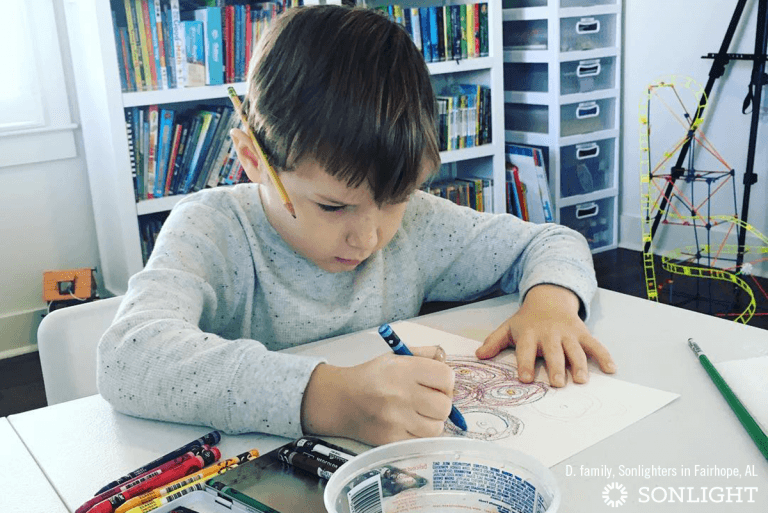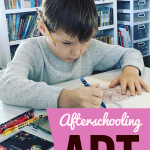
Art as a school subject is in a unique situation. Everyone agrees that it is important. Life is more beautiful, expressive, and fulfilling when we create and can enjoy others’ creations. Art is an end in itself, but what some parents may not know, is that it also improves our lives across all disciplines, including math and reading.
However, art is a soft skill and therefore hard to measure. 2+2 will always equal 4, but not everyone agrees on what is good art, bad art, or even what is necessarily art at all. Because of art's ambiguity, art offerings are being slashed in budget-stressed schools, often getting crowded out by more practical STEM-centric (science, technology, engineering and math) activities. And while I fully support STEM—after all, I am a volunteer youth robotics coach—I keenly feel my own lack of art education. I want my kids to receive more art than I did and be able to fully appreciate it. To make sure a rich art education happens for my kids, we do art at home, after school.
Fortunately, it is easy to implement afterschooling art at home. Best of all, the six strategies I share here require very little preparation from you. Art supplies and a trip to the library or a quick Google search will have you ready to go.
1. Recreate Art from Favorite Artists
This idea is a bit more formal, and works especially well if your children get out of school early one day a week, perhaps on Fridays. When they get home, make your art lessons fun; have snacks and make a mess. Maybe even give it a fun name like Fine Art Fridays or Fridays and Forgeries.
Using a variety of materials is engaging: paints, pastels, clay, stone, wood, mosaics, fabric, food, etc. (I found these no-mess paint sticks, and my kids LOVE them!) Anything can be art! Just use what you have at home or what you can easily and inexpensively get your hands on. You don’t need top-of-the-line materials for this, and a Google search 30 seconds before you begin is all the preparation time you need.
- Select an artist or art movement to study for a set period of time—once a week for a month worked well for us.
- Read a book or watch a video on biography.com to learn about an artist’s life and most famous works. (I especially love this picture book about Michelangelo by Diane Stanley, and this Usborne book has fantastic overviews of several artists.)
- Each week let your little artists try to recreate—or for your mischievous children, challenge them to forge!—their favorite piece of artwork from the spotlighted artist. Try a different masterpiece each week.
- Be supportive, no matter what the outcome is. Remember we want our children to enjoy the process and express creativity!
- Repeat, choosing another artist or movement next month.
When we did this activity, my children were amazed at the variety of art: the Renaissance, Impressionism, melting clocks, splatter paintings, and cubism. Our hallway turned into an art gallery as the children proudly displayed their artwork.
2. Illustrate a Nature Study Notebook
Nature is a perfect place to practice sketching shapes, making colors, and capturing shading. Start a nature study notebook when your family camps or hikes. Get a special sketching notebook for each person in the family and give them time to draw something that captures their attention.
When there is no rush, when you are surrounded by nature, and when there is time to create, your children experience a peaceful, almost euphoric feeling that can’t be replicated. Your children will remember how they feel, as they document the moment with images. In our screen-heavy lifestyle, time with nature is especially important to give the brain and eyes a break from flashing images.
3. Work Through a Formal Art Curriculum
If you feel at a loss for where to start with art studies, relying on a formal curriculum is a safe bet. Artistic Pursuits art curriculum is designed with families in mind, making it a natural fit for afterschooling art at home. Depending on the age of your child, you as a parent might not need to be involved if you have other duties that require your attention.
4. Lean on the Internet
There are a large variety of effective art teachers online. Many are free on YouTube while others charge a subscription fee. As I write this, my seven-year-old is using a free, online tutorial to create a work of art. He could spend hours on this website if I let him, and he loves every minute! I’m pretty impressed at what he’s able to do with the step-by-step support of the videos. If your children are begging for screen time, this is a great option.
5. Scatter Art Books Around Your Home
Sometimes when we push, our children decide to push back and reject our suggestions for learning art after school. But if we casually strew educational resources, they get noticed and used. Scatter these about your house, including the car or van and your bathroom. (Kids will read anything in the bathroom!)
- doodling and cartoon tutorials
- uncommon coloring books
- fun art supplies
- sketching guides
- coffee table art books
- art calendars
If clutter makes you anxious, rely on bins and baskets to keep things tidy but still within eyesight and easy access.
6. Use Everyday Moments To Be Creative
- Do you need a birthday cake? Let a special helper design and decorate it with you!
- Make signs and decorate the house for holidays, arrivals, departures, and special occasions.
- Let everyone help design and make Halloween costumes. We do themed costumes as a family with the added challenge that we need to make them. The results are much more fun and original than any storebought costume would be. We have a blast doing this every year.
- Point out art in everyday life: advertisements, magazines, books, photographs, architecture, clothing, etc. Help your children learn to recognize different types of art.
As we encourage our children to be creative and be vulnerable in their creativity, not only do they become more well versed and grounded in art, they also develop confidence and an appreciation for beauty. Afterschooling art at home is a perfect fit because families are a safe place to reveal our art, home makes the perfect gallery, and Mom and Dad are the best patrons any artist could ask for.








